Want to learn how to make a money personality quiz?
A money personality quiz will attract more clients to your financial services. And best of all, they’re free to make!
And if you’re thinking, Will a money personality quiz really help me get more clients? The answer is yes! Just keep reading this post. I’ll teach you everything you need to know about making and promoting your money personality quiz.
Get ready for more leads and sales. Let’s get started!
Table of Contents
- What is a money personality quiz?
- Who should create a money personality quiz?
- What are the 5 money personality types?
- 5 types of money personality quizzes
- Create a money personality quiz with Interact
- How to share your money personality quiz
- Promote your money personality quiz with a landing page
What is a money personality quiz?
A money personality quiz will help you identify your relationship with money. And by relationship with money, we mean:
Your money beliefs—We’ve all heard the sayings, “There’s enough money to go around” or “Money doesn’t grow on trees.” These are money beliefs.
As a child, you probably heard adults express all types of money beliefs. At some point or another, these beliefs became your own beliefs. And now, as an adult, you might still think of money with those same beliefs.
For example, someone might grow up hearing their parents fight about finances. Maybe they heard their parents say something like “Money is the root of all evil.” So now, this person is afraid of earning money because they believe money leads to evil things.
How you spend money—Your money beliefs show up in how you spend money. If you believe that money always comes back around, then you probably feel comfortable spending it.
If you believe that you must work hard to earn money, then you’ll probably only spend money when you “deserve” it.
Let’s be honest, we can probably all improve our relationship with money, right?
The purpose of a money personality quiz is to better your money relationship and habits. The better your money relationship is, the more money you’ll get. It’s that simple.
Who should create a money personality quiz and why?
A money personality quiz will improve the quiz-taker’s relationship with money and help them get their finances together.
Anyone in the financial or mental wellness industry will do great with this quiz. But why should you create one?
It’s simple—a money personality quiz will attract more clients.
Think about it—money is a sore topic for many of us, especially in this climate. NEFE found that 34% of Americans are “extremely/very concerned” about their finances. It’s easy to feel stress and anxiety at the mere thought of money.
A quiz, on the other hand, is fun, easy, and stress-free. We LOVE taking quizzes!
So why not use a fun quiz to get people excited about money? And why not get more clients while you’re at it?
Below are a few examples of entrepreneurs who attract clients with money personality quizzes.
Life or business coaches—Money is a HUGE part of our lives. And sadly, it’s common to stress about money… big time.
Life coaches like Evelyn Lim help clients (in her case, women) create a new money mindset, AKA money beliefs, with her quiz. Then she leads quiz-takers to her life coaching program.
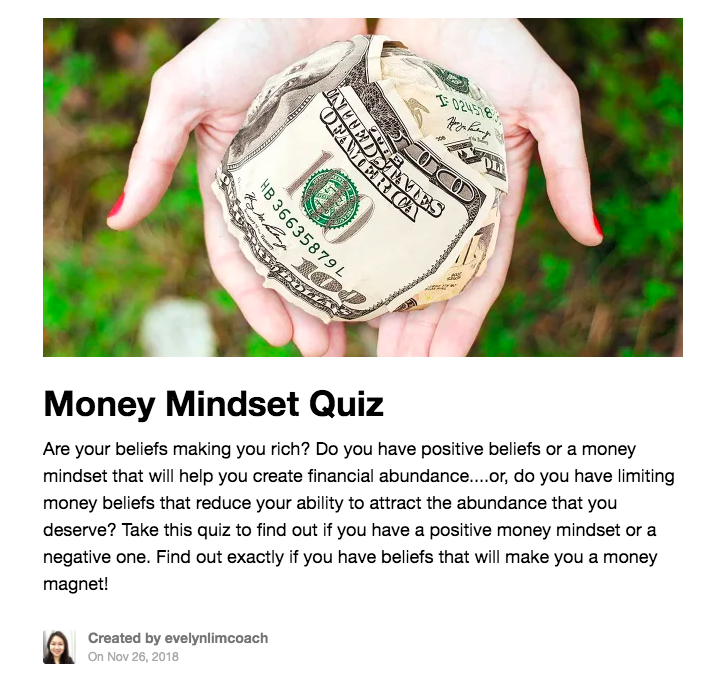
Financial experts—This one’s obvious. Anyone in the financial industry would do great with a money personality quiz.
Ande Fraizer, for example, is a financial advisor and speaker for women. Like Evelyn, she uses a “money mindset quiz” to attract new clients.

Personal finance blogs—Do you run a financial blog? Then a money quiz can help you generate more subscribers.
Take a look at NerdWallet. Their blog is the online financial hub. From choosing a credit card to paying a mortgage, they have tons of resources.
They use a money personality quiz to promote their blog posts and financial app.
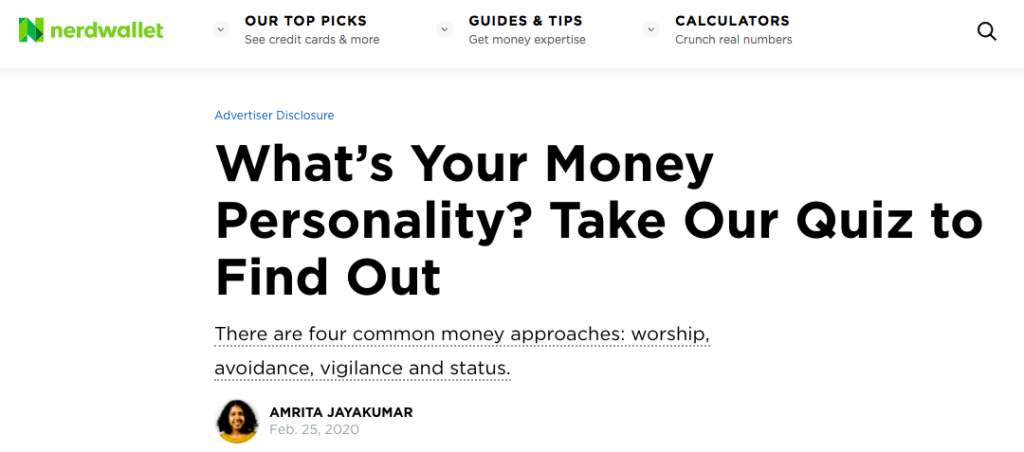
See how easy it is to get more clients with a money quiz? Now you might be wondering how you can create your own money personality quiz.
What are the 5 money personalities?
You can’t create a quiz without quiz results. So before we show you how to make a money personality quiz, let’s go over the five money personality types.
Keep in mind that there isn’t a “best” money personality type. Each type has good and not-so-good traits.
Feel free to use these types as your quiz results.
1. The penny pincher
AKA the saver. This money personality type does not like to spend money. Instead, they save as much as they can.
A penny pincher is best described with a car dealership scenario. (I’ll use the car dealership scenario to describe each money personality type.)
Sam is on his way to his local used car dealership. After days of research, he knows what cars he can and can’t afford. Plus, he’s memorized the pros and cons of each make.
When Sam arrives at the dealership, he goes straight to the used, practical car. All he wants is something safe with good mileage.
He comes across a Toyota RAV4 and a Prius. He knows that the Prius will save him gas money, but he also knows how much bigger a RAV4 is. With a partner and three children, he could use the extra space.
“Well, we’re not planning to go on any vacations anytime soon. And Jan can always take the kids to school. Plus, the Prius is cheaper than my projected price. I know which car I’m choosing.”
With a price in mind, Sam bargains his way to the lowest price possible. He leaves the dealership with the Prius, thinking about Jan. He’s not sure how happy she’ll be about this choice, but hey, at least he saved money.
From this scenario, you can tell that a penny pincher:
- Saves money as much as possible
- Is scared of losing money
- Uses the price tag to make the final decision
With his wife and kids, the RAV4 would’ve been a better investment for Sam. But he couldn’t get past the higher cost. He went with the Prius.
Sure, saving money is necessary. But focusing too much on saving can distract you from what’s important.
So how can a penny pincher better their money mindset?
- Ditch the belief that money is scarce
- Learn how to invest money for the future
- Learn how to use money as a tool
- Buy something for themselves every once and awhile
Now let’s talk about the penny pincher’s opposite.
2. The big spender
We’ve all seen the movie character who spends money on Gucci, Prada, and diamonds. This archetype is the big spender.
Unlike penny pinchers, big spenders focus on the image of money. They flaunt what they’ve got.
If a big spender went to a car dealership, here’s what they’d do:
The new Tesla Model X just came out, and Nathan is dying to buy it. Sure, he already owns a Tesla, but he needs the best model out there. And he’s worked hard so he can spend money on whatever he wants. Why not show it off?
So after work, Nathan drives to the Tesla dealership and points to the new Tesla X. “I want this one, sir.”
“Would you like to look inside and drive it around before buying it?” The salesperson asks.
“No, thanks. I just want the newest model, and here it is!”
As the salesperson finalizes the purchase, all Nathan can think about is where he should drive his new car first. Everyone must see his new purchase. He ends up texting his work buddies to meet at Morton’s Steakhouse. He can’t wait to see the look on their faces when he rolls up.
From this scenario, you can tell that a big spender:
- Shows how hard they work with fancy gadgets
- Believes the most expensive brands are the best brands
- Connects money with their self-image
Big spenders get a bad rep, but remember, there’s no “bad” type. Sure, they spend money on things you might find ridiculous, but it’s because they tie self-worth to money.
In the end, they only want to prove how hardworking they are.
So how can a big spender better their money mindset?
- Buy an item because they want/need it, not because it looks good
- Invest in purchases for people in need
- Use money to buy experiences instead of things
- Ditch the belief that they’re only worthy if they’re rich
3. The investor
Investors are risk-takers and opportunists. They look at money as a way to make even more money.
Here’s how an investor would act at a car dealership:
The other day, Rachel’s car broke down for the third time. She’s owned her car for about twelve years now. It might be time for an upgrade.
On her way to the dealership, Rachel thinks about what she wants in a new car. Rachel currently lives alone in the suburbs, so she doesn’t need anything crazy.
But Rachel has a feeling that her boyfriend will propose soon. And she wouldn’t be surprised if they had kids in the next couple of years.
Keeping these future events in mind, Rachel heads into the dealership and asks about a Honda CRV. Sure, she’s not certain when she’s getting married or having kids, but she bets it’ll happen soon. Why not plan for the future?
Plus, she could use this car as an excuse to go on more road trips. Rachel decides to buy the Honda CRV. It’s out of her price range, but it’ll be worth it in the long-run.
From this scenario, you can tell that investors:
- Make decisions based on the future
- Are comfortable taking risks
- Will spend more money if it’s worth it
- Trust their gut
Investors have a refreshing outlook on money. They don’t look at it as a source of evil, but as an opportunity. With that in mind, it’s easy for an investor to take risks without considering the cons of their decision.
So how can an investor improve their relationship with money?
- Ask for feedback about their big investment ideas
- Consider the pros and cons of their money-making decisions
- Save money for a rainy day
4. The shopper
You might be thinking, Aren’t shoppers and big spenders the same thing? What’s the difference between these types?
A big spender buys items to show off. A shopper buys items to make themselves feel good. Shoppers are also known as emotional spenders.
Here’s what a shopper would do at a car dealership:
Whenever Abby has a terrible day, she drives to the mall for some retail therapy. Today was one of those days.
She gets in her car after work and starts driving to her favorite store. On the road, she realizes how run-down her car has become. She spontaneously stops at the next car dealership she sees, thinking, “It doesn’t hurt to window shop.”
Once Abby starts looking at all the cars, she comes across a shiny, red convertible. She remembers how much she wanted a red convertible as a child. It was her dream car for years.
“There’s no harm in going for a test drive.” She shrugs and talks to a salesperson.
During the drive, she falls in love with the idea of owning a red convertible. Her terrible day is no longer an issue; all she can think about is driving along the beach in her new car.
While Abby doesn’t have the budget to buy a new car, she figures that a payment plan will help her out. In under an hour, Abby leaves the dealership with her new convertible. She even bought a large speaker system, like she always dreamed of.
“Who cares what happened earlier today. I have the best car ever! I feel amazing,” Abby thinks.
From this example, you can tell that shoppers:
- Buy things to feel good
- Use emotions to justify their purchases
- Don’t worry about budgeting
You might hear a shopper say something like, I needed this purchase or I’ll start budgeting after I buy this. They’re aware of their poor spending habits but don’t know how to fix them.
So how can a shopper improve their money mindset?
- Detach feel-good emotions from spending money
- Learn how to stick to a budget
- Replace retail with something healthier, like working out or talking to a friend
5. The Avoider
And last but not least is the avoider. The avoider hates the idea of money and avoids the topic at all costs.
In fact, no car dealership scenario is needed for this type. Making a big purchase, like a car, is overwhelming for them. They wouldn’t go to a car dealership until they absolutely had to.
Here’s how the scenario would go:
“Hey, Sean, thanks for letting me borrow your car today,” Sean’s friend, Mickey, says. “I noticed that your car bumper is coming off. And your mileage is really high. I know someone who’s selling a car. Are you interested?”
“No problem, Mickey. And what are you talking about? My car is working fine! And anyway, nice cars are for rich people.”
“Are you sure? I mean… your mileage is really high. My friend’s car runs really well. It’s not about having something nice, but something that works,” Mickey adds.
“Eh, maybe later,” Sean responds anxiously. “I have other things to think about.”
As you can see, an avoider:
- Believes buying nice things is bad and only for wealthy people
- Feels uncomfortable when money is brought up
- Avoids talking about money at all costs
As you already know, money is a stressor for many of us. So for avoiders, it’s better to not think about money at all. They probably grew up in an environment where money was seen as “evil.”
So here’s how an avoider can improve their money mindset:
- Forget the belief that money is evil
- Learn how to use money as a tool
- Learn money management basics and improve from there
- Realize that money can be used for good every day
And those are the five money personality types! As you can see, each type has distinct features. And they can all improve their money mindset in one way or another.
Now that you know what each money personality type looks like, you might wonder what type of money personality quizzes exist.
5 Types of Money Personality Quizzes
So you know what a money personality quiz is, why you should make one, and each money type. But what about the quiz itself? What types of money quizzes can you make?
We found five different money personality quizzes to inspire your own quiz. You should also take a look at our money quiz templates for more ideas.
1. What’s your money belief?
NerdWallet attracts new users to their financial resources with a “What’s Your Money Belief” quiz.
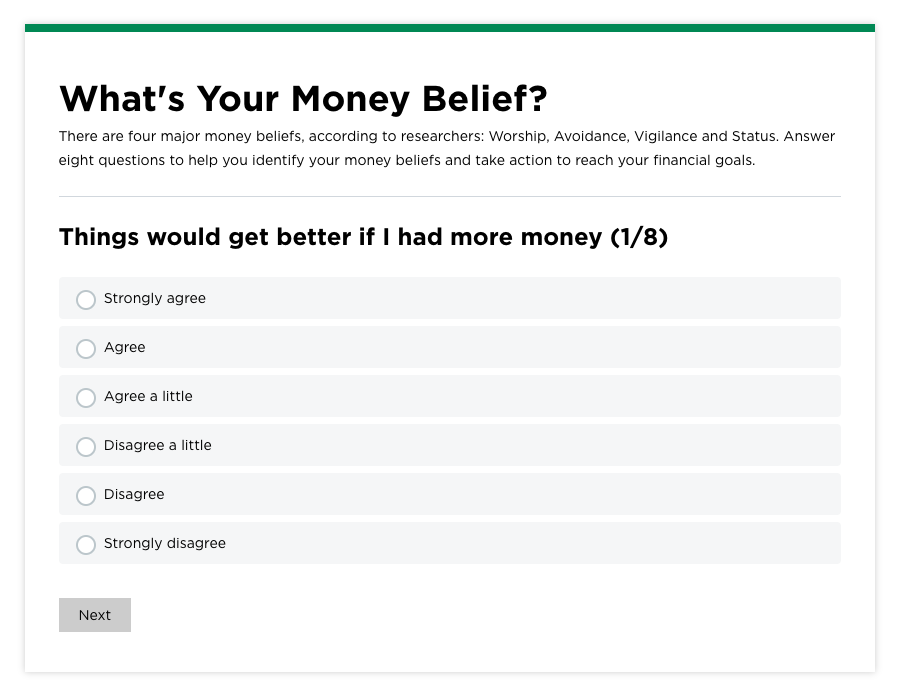
“What’s Your Money Belief?” gets to the source of their client’s financial struggles. This type of quiz asks statement-questions, like the below, and the quiz-taker answers whether they “agree,” feel “neutral,” or “disagree.”
- I don’t deserve a lot of money if others have less than me.
- You shouldn’t tell others how much money you have.
- Most poor people don’t deserve to have money.
- More money makes you happier.
- Rich people are greedy.
All of their questions target money beliefs we learn as children. This type of money quiz helps quiz-takers identify their beliefs and break them down.
2. What are your money instincts?
Another type of money personality quiz you can use is Simple Dollar’s “What Are Your Money Instincts?”
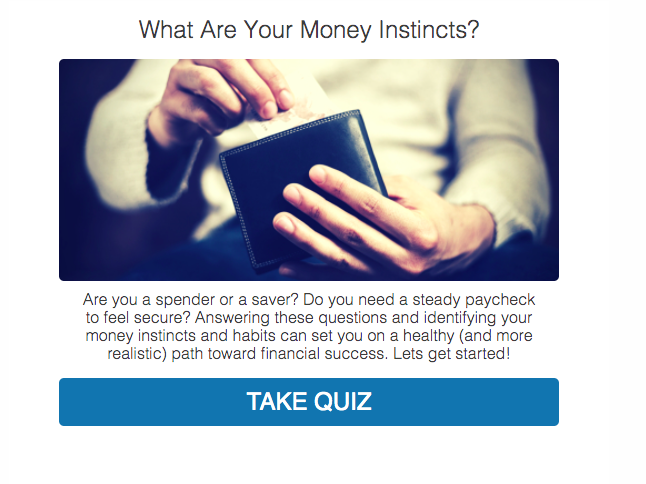
This quiz is similar to a money belief quiz. Once a quiz-taker is aware of their money habits, they can take charge of their financial goals.
In this quiz, Simple Dollar asks scenario-questions—what would you do in certain money situations?
- You’re due for an upgrade on your phone. Your current one still works but you’ve had an eye on the newer version. You decide to…
- What do you do when you go grocery shopping?
- Congratulations—you got a bonus at work! What do you do with the money?
- Your 401(k) paperwork comes in the mail, asking if you’d like to increase contributions. You…
- Your friend’s birthday is coming up and you’re low on cash. You decide to…
Scenario questions get readers thinking about how they react to money. This is a good way to pinpoint financial habits.
Oh, and not to mention, Simple Dollar used our software to build this quiz!
3. What’s your money mindset?
Similar to the quizzes above, you can create a “What’s Your Money Mindset?” quiz like Ande Fraizer.

Ande describes a money mindset as “a set of core beliefs about money.” When you know these beliefs, you can change your thoughts about money.
Ande used statement-questions to build her quiz, like:
- When I was young, I often heard the adults in my life talking about money.
- Women have different needs than men when it comes to money.
- I’ve set my own clearly defined financial goals.
- I’m an independent person.
- I maintain a detailed list of my expenses.
Notice how her questions target the quiz-taker’s money habits, like budgeting and goal-setting. This is a useful way to find out your client’s money personality.
4. What Would You Do?
Rachel Cruze takes an interesting spin on a money quiz with a “What Would You Do?” assessment.
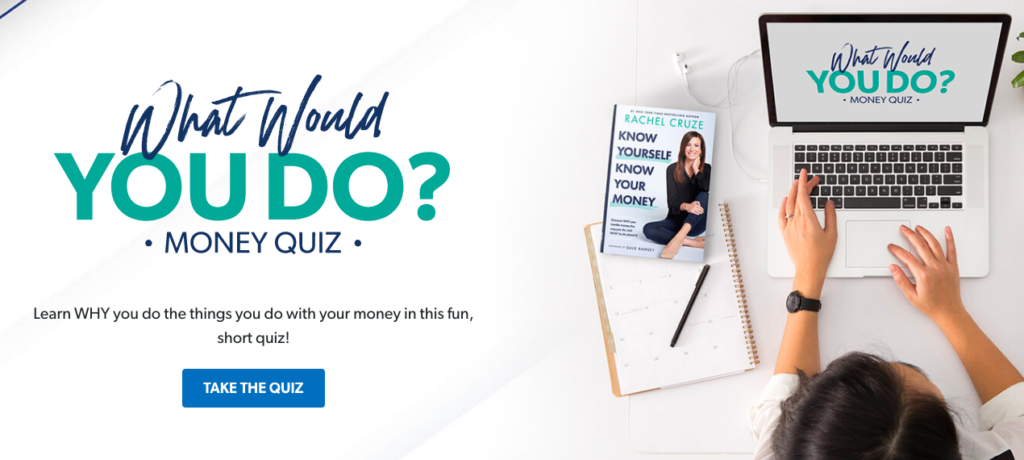
With this type of money quiz, you can figure out why your quiz-takers spend money. Rachel uses both statement and scenario questions to find out more about her quiz-takers.
- Do you agree with this statement? If I receive $50 for a birthday gift, I have a hard time holding on to it.
- Your friend invites you to go to a Taylor Swift concert, but the $200 ticket is not in your budget. What do you do?
- When you were a kid, did you ever save up money to buy something big? After hours of babysitting or mowing lawns, when the day finally came to buy it, how did you feel?
- You worked hard this year, and your bonus from work was more than you expected. What’s your first thought when the direct deposit hits your account?
- There’s a toilet paper shortage due to a global pandemic and quarantine (oh wait, this one really happened). How do you handle it?
The best part about Rachel’s questions is how realistic they are. Anyone could relate to these scenarios. And she kept her quiz current with a question about COVID-19.
5. What’s Your Sacred Money Archetype?
You know trade-marked personality quizzes like Myers-Briggs? Well, there’s one for money, too!
“The Sacred Money Archetype” identifies people as one of the eight sacred money archetypes. Each archetype holds your “money code” to unlock your financial superpowers.
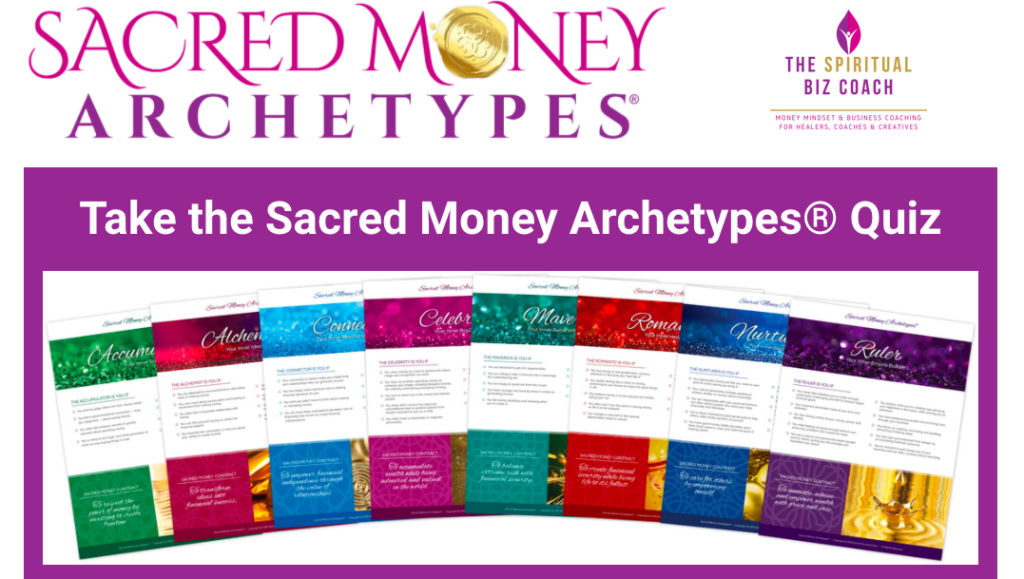
This type of quiz gets deep into the spiritual side of money. It’s not just about your actions, but also what you put out in the universe.
Some questions this type of quiz asks are:
Agree, neutral, or disagree?
- I am a generous person, often giving or loaning money to others.
- I like calculating the pros and cons of taking money risks.
- I secretly feel clever or even superior to others regarding money.
- I
- Despite my best efforts, something often happens to complicate my life financially.
These questions dig into your psyche. Quiz-takers can identify their unconscious motives about money through this quiz.
With all of these quizzes, there’s no way you’ll run out of ideas. Now that you’re filled with inspiration, let’s get to the good stuff—how to make a money personality quiz!
Create a money personality quiz with Interact
The best way to create a money personality quiz is with Interact. Our quiz-making software makes it easy to design quizzes in a day (or less!).
Plus, we offer a ton of quiz-making features, like:
- Hundreds of quiz templates
- Conditional logic
- Quiz design elements
- Everything you need for an email opt-in
- Functionality to embed a quiz to your website and social media platforms
If you don’t already have an account with us, you can sign up for one here. Let’s get to it!
- Choose a money personality template
- Design your money personality quiz
- Build a cover page
- Create quiz questions
- Make a results page
- Correlate answers and results
How to Create a Money Personality Quiz
1. Choose a money personality template
The easiest way to make a money personality quiz is with our financial templates. You can find these templates on our home page.
Click Quiz Templates at the top menu.

You’ll see a list of our quiz template options. Choose Finance to view our money-related quizzes.
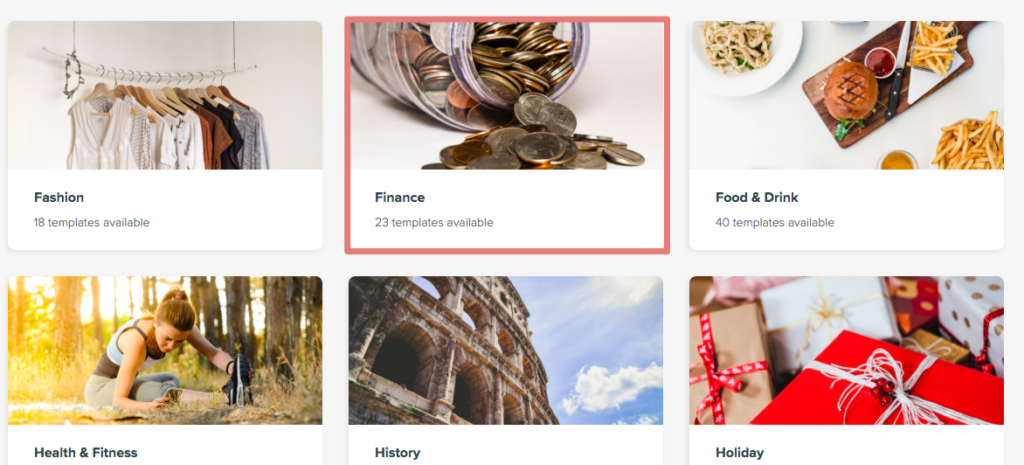
In this tutorial, I’ll use the template, “What’s your money personality?”
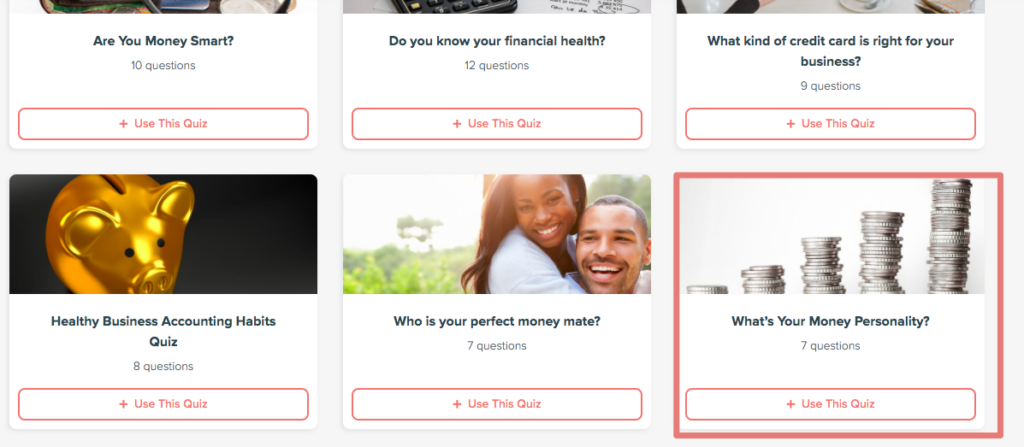
Click Use This Quiz. A new window will appear and ask you to copy the quiz. To do this, click Clone This Quiz. From here, you’ll be taken to your quiz editing page.

See how easy that was? Now we can get to the fun part—designing your money quiz.
2. Design your money personality quiz
Your quiz is the first thing new users see about your business. It should accurately represent your brand.
You can do this with our customization features. Use the toolbar at the top to change your quiz colors, logo, and font.

Quiz colors—Do you have a brand color scheme? Use it for your quiz. If not, you can always check out our quiz design guide to choose the best colors.
Font—Choose a font that’s easy for your audience to understand. Remember, quizzes are fun and short, and your font should be easy to read.
Logo—There’s no better way to brand your quiz than with a logo. Not to mention, adding a logo will keep anyone from stealing your quiz for themselves. When you add a logo, it’ll appear at the right-bottom corner of the cover page.
3. Build a cover page
Like your quiz design, your cover page is the first part of your quiz users will see. Make it memorable!
Every cover page needs a quiz title, cover image, description, and call to action. Let’s talk about each of these.

Quiz title—Your title doesn’t need to be anything fancy. You can use something simple like “What’s your money personality?” or “What’s your money mindset?”
Cover image—When it comes to a cover page, images speak louder than words. Use an image your audience will find exciting.
For example, if your audience is made up of parents, then represent both money and family in the cover photo.
With our Edit cover image setting at the top, you can choose from hundreds of stock photos or upload your own images.
Quiz description—If you don’t know how to describe your quiz, then ask a question. A good question will get a user’s attention.
Notice how the cover page above uses the question “Have you planned out every move when it comes to finance, or do you open your wallet to find nothing but a few pennies?” This gets an audience thinking about their money habits.
Call to action—In this case, the CTA is “Take Quiz.” If you want to use another CTA, try:
- Learn your money personality!
- Start your money transformation
- Change your money habits now
And that’s all for the cover page! Now let’s talk about quiz questions.
4. Create quiz questions
You can find the quiz questions at the left-hand toolbar.
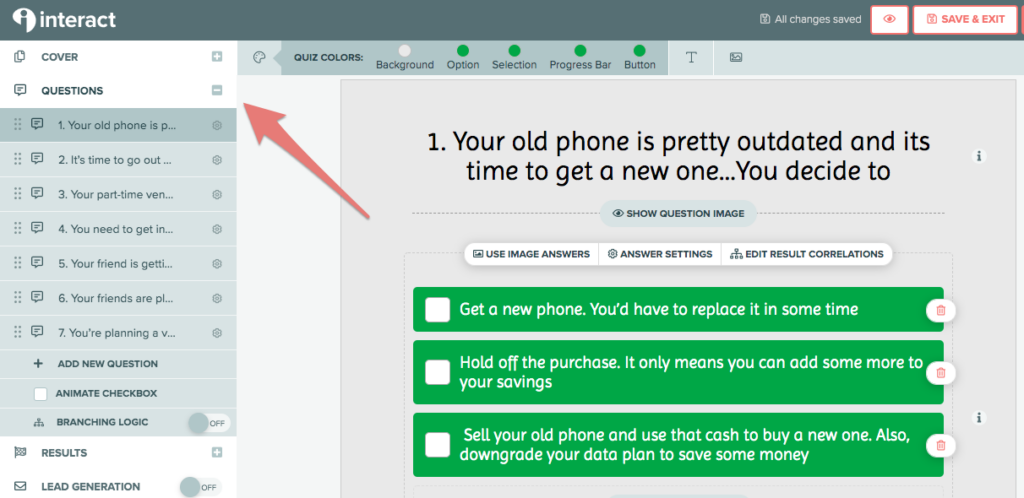
If you’re thinking, I don’t have any of my questions ready yet! Then head over to our post, How to ask better questions, and come up with 10-12 quiz questions and answers.
When your questions are ready, you can design the page.
Image answers—If you click Use Image Answers at the question toolbar, then your questions will look like the below:

Image answers help quiz-takers imagine each answer with detail. They also make your quiz look more fun.
Multiple answers—Want quiz-takers to check off more than one answer? Then head to Answer Settings and click Select Multiple Answers.

And remember, you can change these settings for each question.
5. Make a results page
Your results page is the most important step for getting new clients. Your results page should:
- Describe each quiz result in detail
- Tell your audience something new and valuable about themselves
- Guide them to your call to action (blog post, product, coaching service, etc.)
You can find your results settings at the left-hand toolbar under Questions.
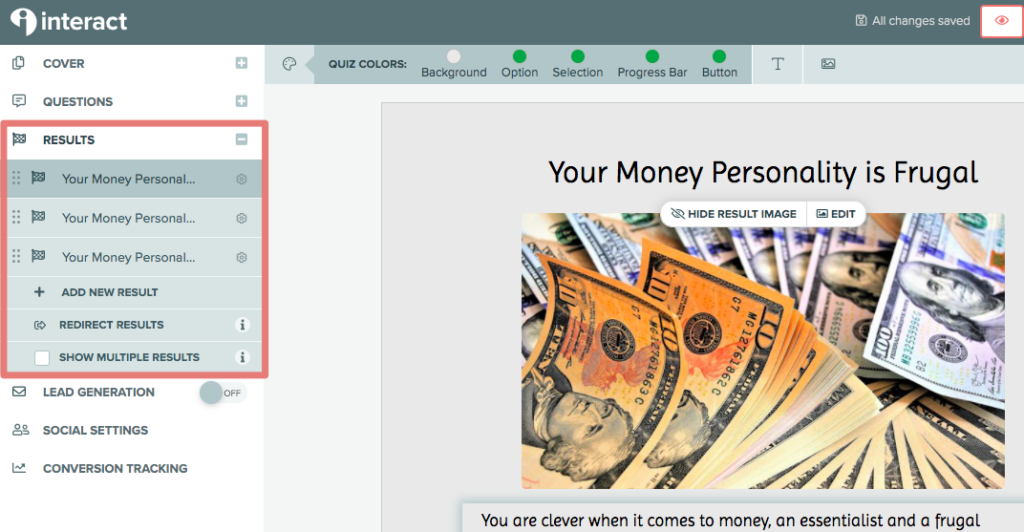
To give you an idea of a high-converting results page, let’s take a look at Denise Duffield’s results page. Denise uses a money personality quiz to grow her coaching business.
Let’s start at the top.
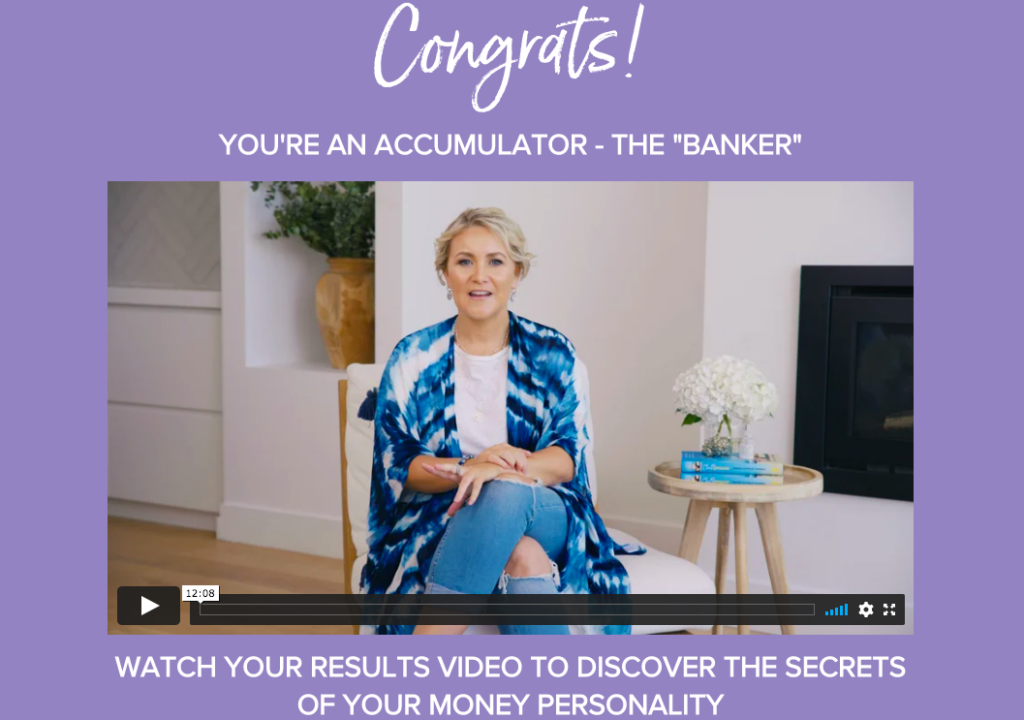
While most pages use an image to reveal results, Denise records herself explaining each quiz result… and it’s twelve minutes long! Talk about value.
Notice how she starts off the page with “Congrats!” Positive language makes people feel good about their results. You can also use:
- Amazing! You’re a (quiz result).
- Your journey has just begun! You’re a (quiz result).
- Awesome job! You’re a (quiz result).
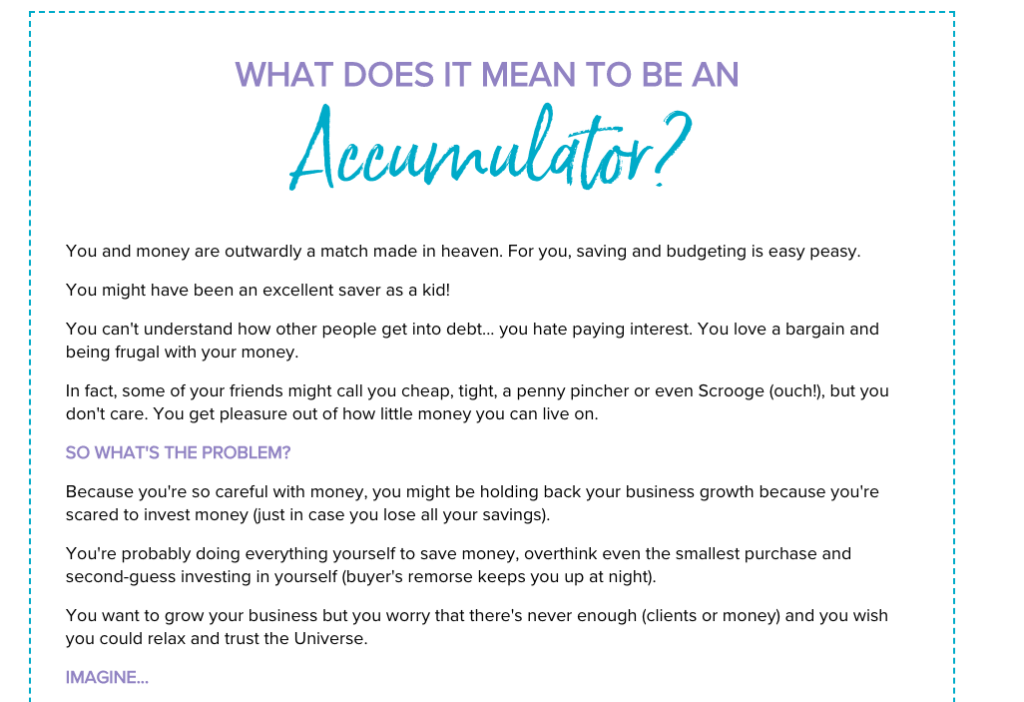
In this next section, Denise describes “The Accumulator.” But most importantly, she targets the user’s pain point under “So what’s the problem?”
People want to invest in better versions of themselves. So when you pinpoint their struggles, they’ll think, This person knows what they’re talking about. Maybe they can fix my problem.
And that’s exactly what Denise does! After pointing out what this money type struggles with, Denise envisions what life could be like for them under “Imagine.”

So far, this page has pointed out the reader’s strengths, weaknesses, and desires. At this point, the quiz-taker is thinking, Wow… I feel so seen. I do want to X, X, and X. How can I get there?
Queue: Your call to action.
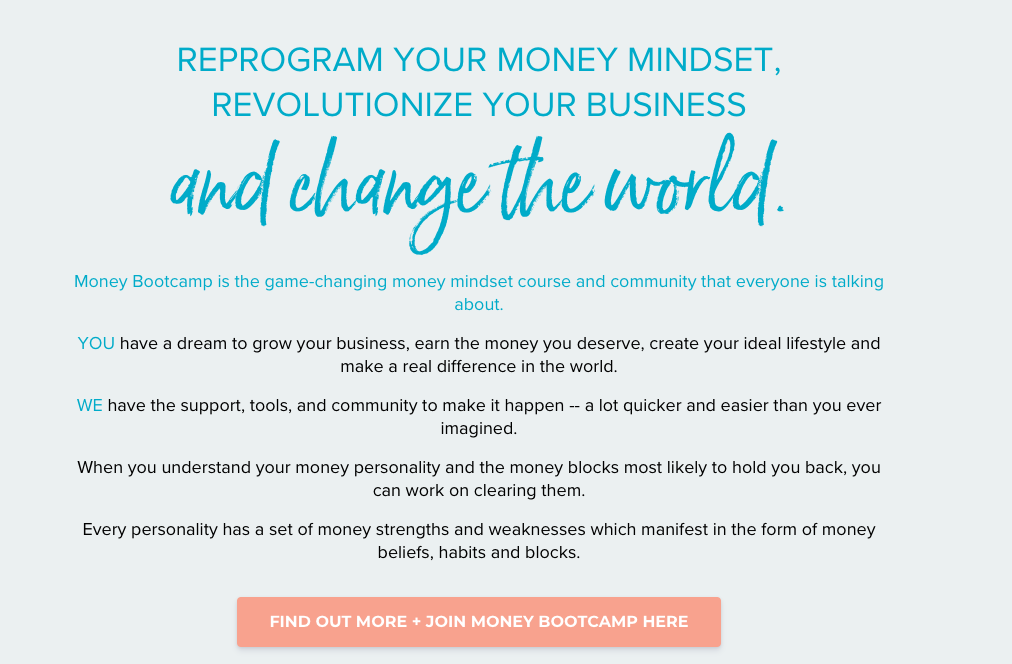
Denise’s solution is her Money Bootcamp online course. Using this CTA, she tells users that her course will:
- Transform their money mindset
- Reach business and money goals they’ve always dreamed of
- Get support from her and the Money Bootcamp community
And this is just the first part of her call to action. She adds even more content at the bottom.

In this last section, Denise:
- Spreads empowerment
- Adds another call to action button
- Includes a testimonial
Testimonials are HUGE! Make sure to add your best social proof at the bottom of your results page. People want to know how much others love your service.
I bet you have a ton of ideas to build a results page, right? And you can always check out our guide, How to create a quiz result landing page that dazzles your audience, for more tricks.
6. Correlate answers and results
We’re almost done with your money personality quiz! The last step is easy. All you need to do is connect your quiz questions with each result.
So head back to your first question and click Edit Result Correlations.

The next page should look something like the below.
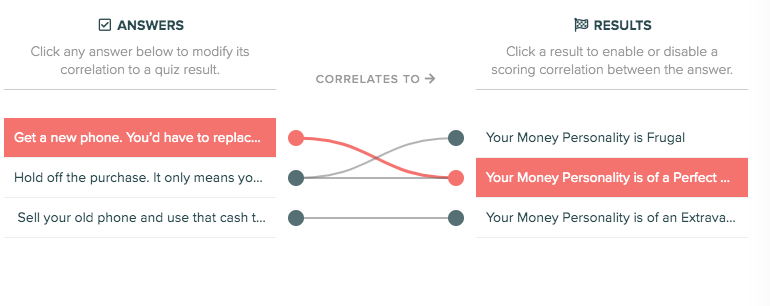
From here, connect each quiz answer to a result page. You can add more than one answer to a result if you’d like.
And once you’ve correlated each question, click on the eye icon at the top to preview your quiz. Then click Publish, and you’re done!

That wasn’t too bad, was it?
How to share your money personality quiz
Now that you’ve finished making your money quiz, promote it! With Interact, you can easily embed your quiz on your website and social media.
I’ll start with social media. On your dashboard, click Share & Embed next to your money personality quiz.

Another window will appear with a few options. The first one, Share Link, gives you a link to share with friends and future clients.

To share your quiz on social media, click any of the social media icons at the bottom. For example, you might want to share your money quiz on Twitter.
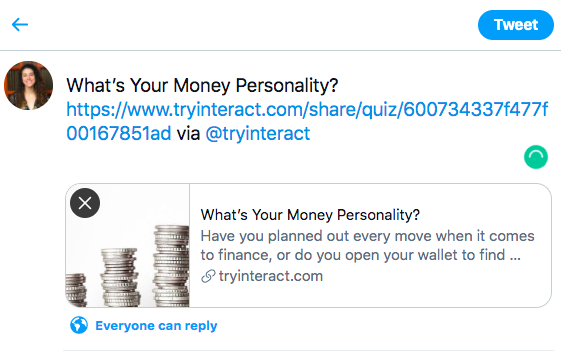
When you click on the Twitter icon, an automated tweet will appear. Just click Tweet at the top-right corner to send it.
What if you want to embed the quiz on your site? Then click Embed Code.
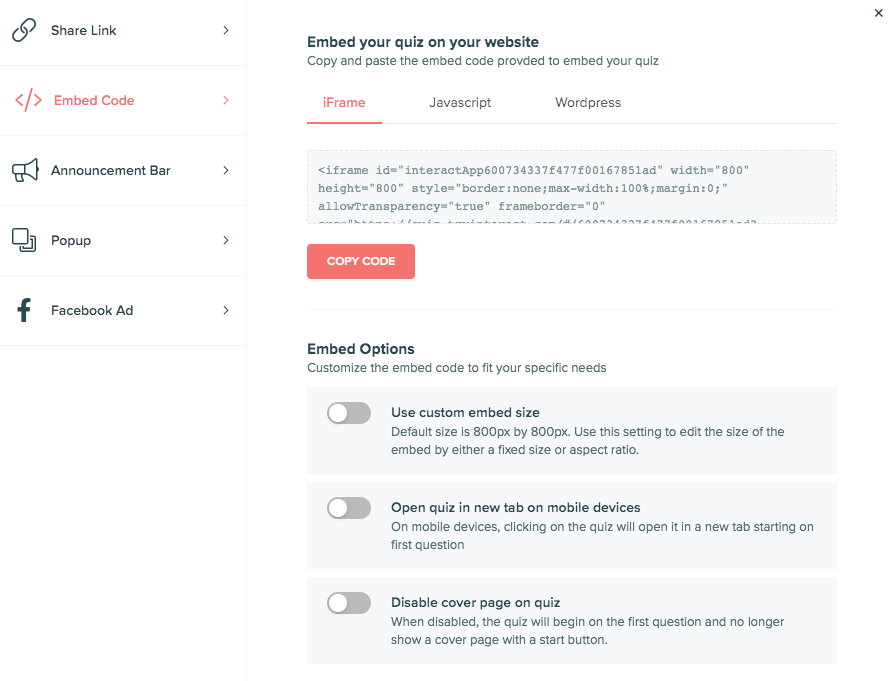
All you have to do is copy and paste the right code to your webpage. If you run into any issues, check out our help center. You can also chat with us at the bottom right-hand corner.
So here’s a question—why promote your quiz by itself? Why not create a landing page?
Promote your money personality quiz with a landing page
A landing page is where the magic happens, AKA, where your quiz generates future customers. It’s one of the best ways to promote your quiz!
Here’s why:
- It tells users what your quiz is about
- It tells them why they should take your quiz
- It attracts new clients
So how do you create a landing page, anyway?
You can use landing page software, like Unbounce. Or use an image editing tool, like Canva.
But first, let’s talk about what a good quiz landing page looks like. Take a look at Heather Hanson’s “Sacred Money Archetypes quiz” landing page.
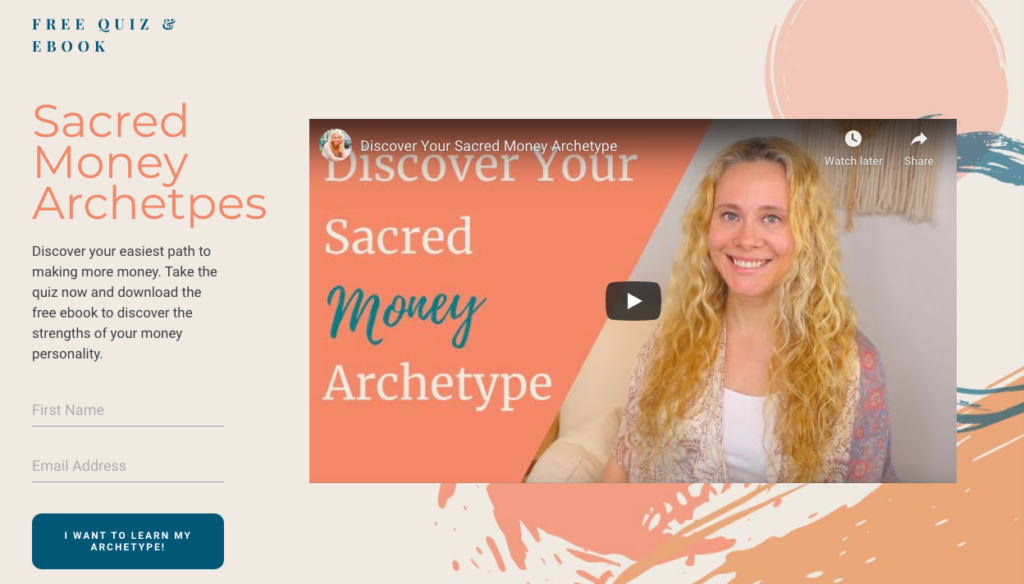
If you’re interested in a simple landing page, then look no further. See below for the best features of her page.
Video—Landing pages are built for new users. They don’t know anything about you or your business. This is why videos come in handy.
A video will connect you to each visitor. Videos are more personable than images because visitors see and hear you speak.
Freebie—Heather offers quiz-takers a free e-book about their results. Remember, the more value you offer, the more leads you’ll get.
User-friendly features—The email opt-in forms makes it easy to sign up for the quiz. No navigation is involved; everything you need is on the page.
And guess what? You can always embed your quiz onto your landing page, like below.

See how easy it is to take Ande’s quiz? It’s right on the page. What a great way to lead users straight to the source.
If you want to embed your quiz on your landing page, then check out our guide, How to embed your quiz on any website.
The last landing page I’ll look at is Empower Bank.
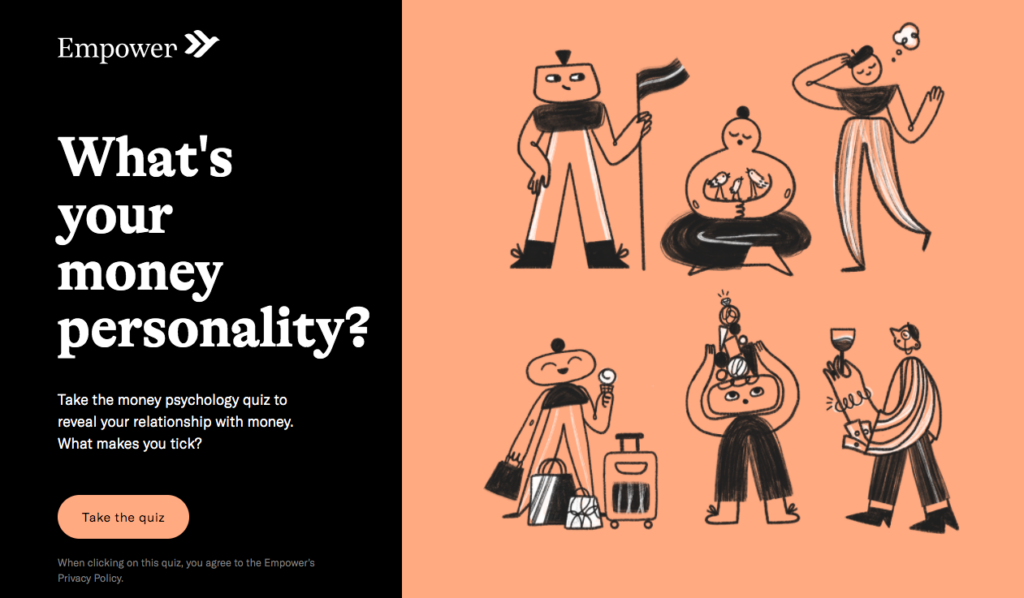
Let’s stop and appreciate Empower’s illustrated designs and color scheme. It’s unique and easy on the eyes.
And take note of the call-to-action button. A user can either start the quiz immediately or keep scrolling for more info.
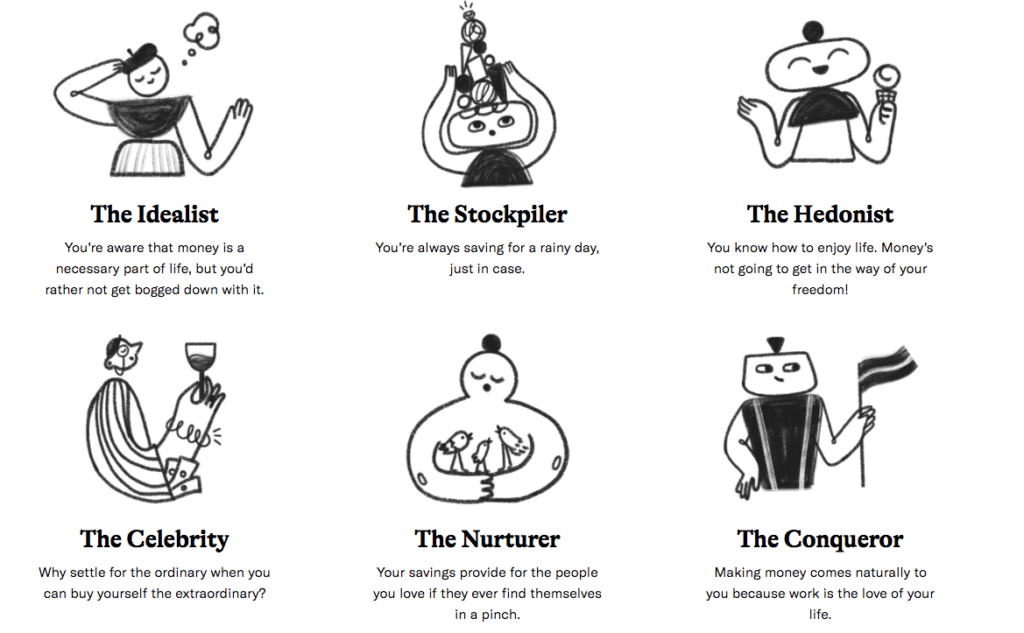
This is the best part of Empower’s landing page. They describe each money personality type with a cute illustration and archetypal name.
When a user reads this, they’ll think, I wonder which one I am! And there’s no better way to find out than taking the quiz, right?
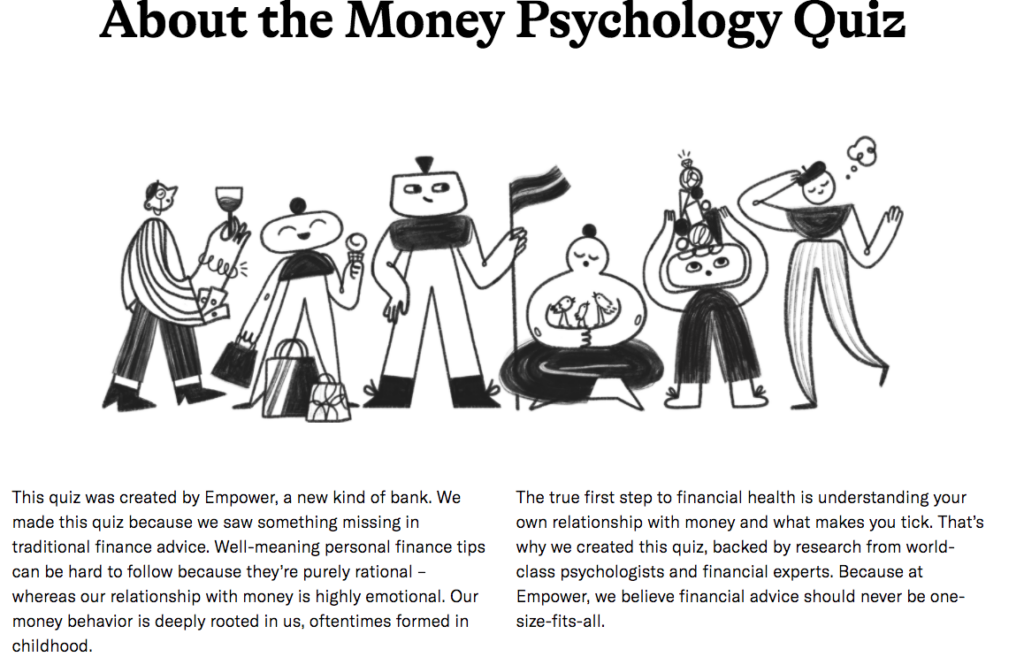
Last is the “About” section. In the description, Empower sets themselves apart from other banks. They don’t fit in with traditional financial advice. Instead, they take a holistic approach to financial problems.
Notice how they mention the words, “psychology” and “world-class psychologists.” This language gets users thinking, This quiz will help me understand my money habits on a deep level.
Overall, there are a few things to take away from each landing page.
- Add a video of yourself talking about each quiz result
- Include fun designs
- Tell users why they want to take your quiz
- Give extra value, like an e-book
As you can tell, a landing page makes promoting your quiz easier. And when you’re done creating a landing page, share it on your website and social media handles.
To wrap up
You now have all the tools you need to create a money personality quiz! Here’s what you learned throughout this post:
- What a money personality quiz is
- Why you should create a money personality quiz
- Money personality quiz examples
- The 5 money personality types
- How to create a money personality quiz with Interact
- How to share your quiz
- How to make a quiz landing page
The only thing you’re missing is an email list. Take a look at our guides, Why you need an email marketing strategy and the Complete list building guide to get started with email list building.
And don’t forget to create your own interact account if you haven’t already!